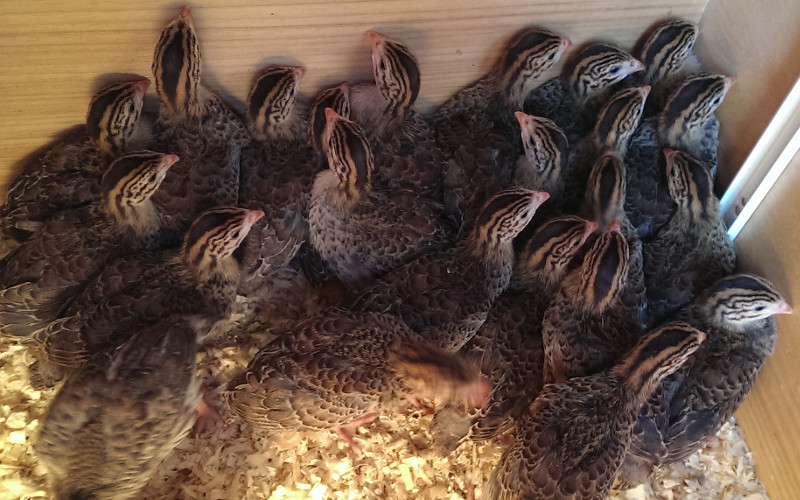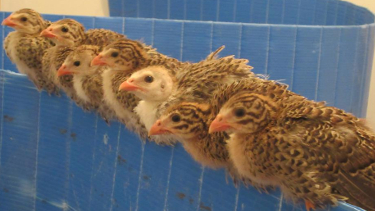Raising Guinea fowl keets successfully.

Essential things you need to know about raising Guinea fowl keets?
It goes without question that Guinea fowl are one of the most unusual, quirky and wacky birds around and their babies are no different. Guinea fowl babies, also known as keets, are excitable and, if I'm being honest, some of the daftest baby creatures around.
Below: Keets fly well from an early age and get into trouble easily.

Caring for young Guinea fowl keets is one of the most rewarding experiences you can have with an animal. So long as you can cope with noise, have a sense of humour, the patience of a saint and are well informed, raising Guinea fowl keets will be relatively easy.
What to expect from Guinea fowl keets:
Guinea fowl keets are cute, chirpy, curious and clumsy things that you’ll definitely need to keep an eye on. They are easily panicked and can hurt themselves by rushing into brooder walls. They are a handful and you should be ready for them. They are not easy to look after like chicks.
Below: Guinea keets in a brooder.
They scurry about the brooder dazed, confused and excited seemingly without any sense of what they are or where they’re going. This leaves them unfortunately prone to accident, such as dislocated legs, which often results in death if it occurs at an early age.
The Keet brooder:
A keet brooder is a safe temperature controlled space, normally an extra-large plastic container or tote, that your baby Guinea fowl will be able to spend the first six weeks of their life.
What bedding is best for keets?
Sand is the best bedding and brooder floor covering for keets.
Plain old washed builders sand. It is dead cheap and has many advantages.
Keets will often eat wood shavings and because of the mess they make with water sand will give you a dryer brooder.
How do you keep Guinea keets warm?
The brooder needs to have a warm spot that is around 38 degrees Celsius, otherwise your Guinea fowl keets might get a bit cold. They should have a source of heat but be able to wander away from it if they need to.
Keets are better able to regulate their own body temperature than chicks and require less brooding.
A carefully positioned heat lamp checked with an accurate thermometer in the bottom of the brooder is the simplest way to ensure your keets stay warm during this early period of their life.
If your Guinea fowl keets are huddled together with their eyes closed or squinted, this is a sure sign that they are feeling cold and you will need to warm the brooder up. They will make more noise if cold which you might think impossible given the normal volume.
Cleaning the brooder:
Guinea fowl keets grow quite fast over the first two weeks and it might be tempting to let them out of the brooder sooner than it is recommended.
Guinea fowl keets should remain inside the brooder for at least the first six weeks of their lives If the weather is nice and sunny you can put them out on the grass
So long as you watch the keets as they begin to explore and keep them confined whilst young they should remain safe from any of the dangers.
What do Guinea keets eat and drink?
Adult Guinea fowl are one of the most self-reliant poultry birds around.
They are able to graze in your garden all day, eating entire armies of bugs and insect, whilst scavenging all other kinds of treats and goodies.
As most Guinea fowl keets won’t be safe to graze outdoors on their own and should be fed a turkey ration with extras to keep them amused. I have a whole article on feeding keets and growers.
Guinea fowl keets need to drink water. The important thing to note about this is the fact that you will need to secure a drown-proof waterer, otherwise you might wake up one morning to find a nasty surprise inside your brooder.
Problems with Guinea keets:
One of the sadder realities about Guinea fowl keets is that if they’re exposed to some kind of trauma during the first few weeks, the more anti-social and fiercely independent they will become.
For example, if the other keets tease, bully or attack one particular baby Guinea fowl, it is likely that they will become less socialised as an adult. An anti-social Guinea fowl will be more inclined to chase, tease or act aggressively towards other animals and even humans.
Guinea fowl have many charms but they are definitely not known for being good parents.
Guinea fowl mothers tend to isolate their nest in the wild and savagely protect it from other birds, animals and even humans. Whilst caring for the eggs Guinea fowl are dedicated and caring parents committed to the cause of their offspring.
Below: A Guinea hen with her keets.

Sometimes when the Guinea fowl keets have hatched the mothers tend to lose interest, wander off and quite generally neglect their young baby keets.
Some owners take young Guinea fowl keets into their care if the mother has abandoned them. Be wary if you try take the baby keets, as the mother may get annoyed and try to drive you away.
Why do Guinea fowl keets die?
Guinea fowl keets die for several reasons:
- The cold - keets are initially very tender, and should not be hatched too early in spring, as a cold March wind is generally fatal to them.
- Getting wet. Guinea hens pften lead their keet through damp grass in the mornings and they get wet and die in very quickly.
- The heat - may seem odd but they like to be able to get away from the heat source.
- Coccidiosis - This preventable condition can kill keets quickly.
- Illness - bacterial, fungal or viral infections.
- Accidents - I have seen one kill itself running head first into the edge of a wall.
- Sometimes the never seem to learn to eat and die very quickly.
They should be fed like turkey poults, and almost immediately, within six hours of being hatched, and abundantly as they will die if kept without food for 12 to 24 hours.
Guineas require higher protein feed than chickens. Egg boiled hard, chopped very fine, and mixed the feed is one of the best things. Guinea fowl keets s should have a constant supply near them until they are allowed to have full liberty and forage for themselves.
They will soon pick up insects and will keep them-selves in good condition with a little extra food.
They are very strong on their legs, and those hatched under common hens may be allowed to range with her at the end of six weeks, and be fed on the same food and at the same times as other chickens.
Buying in Keets:
Most Guinea fowl breeders will also sell the keets, from as little as one day old.
It’s in your best interest to get as young a Guinea fowl keets as possible, as they have trouble adjusting the new environment as they get older, which you can read about here.
It’s probably best to call the breeder and arrange a suitable time to come and collect the keets, as they are likely to know when the next batch of Guinea will hatch.
Once your Guinea fowl have come of age it’s important that they have a safe and sturdy coop to rest in at the end of a fun day eating bugs. Be sure you find out more about how you can keep Guinea fowl with chickens, especially if you’re planning on getting a big and comfortable coop.
As the Guinea fowl seldom shows much disposition to incubate if kept under restraint, and frequently sits too late in the season to rear a brood in this country, it is a general practice to place her eggs under a chicken.
Frequently if old birds are bought, they will wander away for miles in search of their old home, and never return.
About twenty of the earliest eggs should be set in May.
The Guinea-hen will hatch another brood when she feels inclined. They sit for twenty-six to twenty-nine or thirty days. She generally rears a large brood, twenty not being an unusual number.
